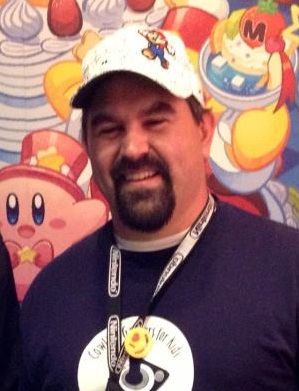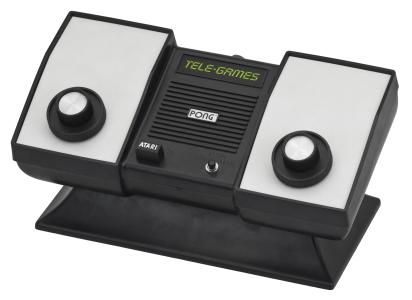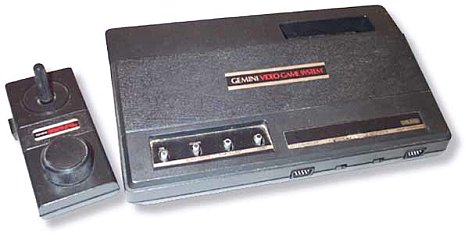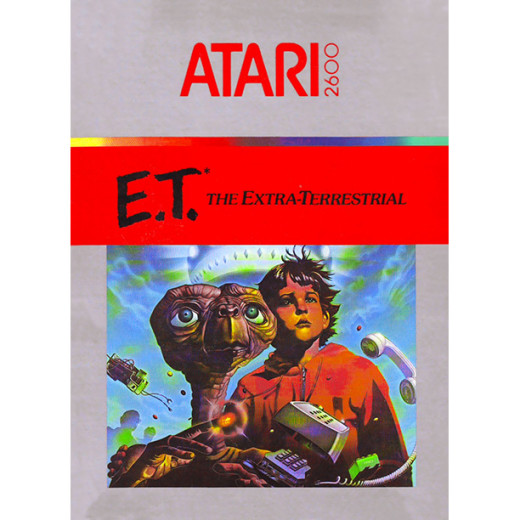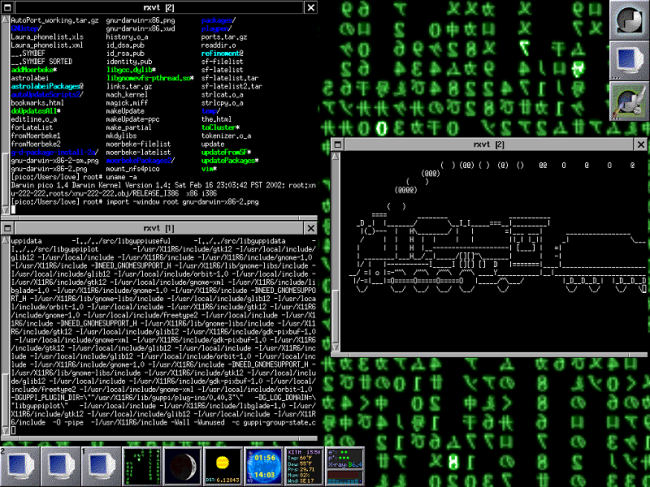Archive
Is Disney Using the Force on Critics?
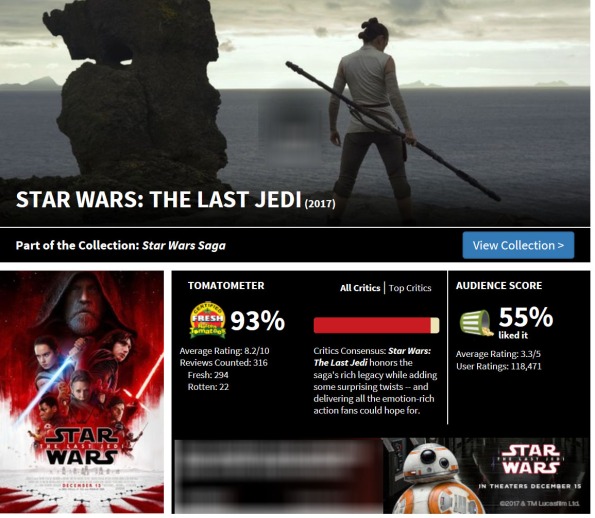 From Rotten Tomatoes, 93% From Critics? How did they pull this off? I detect a disturbance!
From Rotten Tomatoes, 93% From Critics? How did they pull this off? I detect a disturbance!
MMA Fighter ‘Captures’ Opponent with Pokeball
WOW. I can definitely say I’ve never seen this happen before! Ouch!
Thoughts on Pokemon Go
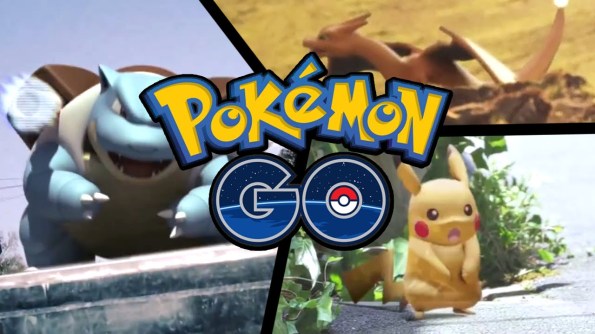 Some thoughts on Pokemon go that crossed my mind today :
Some thoughts on Pokemon go that crossed my mind today :
1- They can’t/shouldn’t let this fly solo for too long. The clones will all fail unless one of them is shockingly good, which is so unlikely that it would be mind blowing if anything but more shovelware comes out. Nintendo should continue getting their other IPs involved in similar ways. I listen to Sports radio and this is a current water-cooler topic, but we are in somewhat of an echo-chamber in regards to our gamer community (mostly 25-40 year olds who ALSO grew up with video games). NOBODY on these shows knew anything about Pokemon really, and of the people that tried it, nobody was very interested. They weren’t hostile to it, but because they were too old when Pokemon first came on the scene, it didn’t ‘click’ for them. An AR ‘Nintendo‘ Universe could be the thing to do that, have minigames, a light version of Smash Bros, a light version of Kart racing, etc, with collectible Nintendo characters. 8-Bit Mario, Wii Fit girl, DK, etc.
![]()
2- Fitting in with that idea, they should do cross-play stuff with their other products such as 3DS, WiiU, and NX. As in : find/collect stuff in the mobile/AR world, and be able to import some select things as add-ons for MK/Smash/whatever, and vice versa. Buy Zelda for WiiU or NX, and get a special character in the mobile Nintendo Universe.
3- As I’ve been saying for YEEEEEAAAAAAAARS, it’s WAAAAAY past time that Nintendo expanded Pokemon beyond their handheld devices. Yes, we’ve had some underwhelming games like the Stadium and Flash games, but a full-fledged Pokemon console RPG (with a multiplayer element) could be a legitimate system seller for a LOT of fans. And now would be a better time than ever before, because it could cross-play with Pokemon Go. I’ve NEVER heard a good reason against it, it just boggles the mind.
4- Yes, this ONE game is currently majorly hyped, but let’s not kid ourselves. Phone/Tablet gaming STILL suffers from massive loads of crapware/shovelware, currently beyond anything the early 1980s could imagine. For every ‘Pokemon Go’, there are 25,000 mediocre to garbage-tier games clogging the stores. Worse yet, the way people expect to pay little/nothing for the games along with the rule of thumb being to make the game quickly impossible/painful to play without paying for crap adds up to APP fatigue on these marketplaces. People go through a honeymoon phase where they have fun with tons of little games/etc, then they get the idea and the novelty wears off, and only a few major hits break out of any note. It’s extra agonizing when they use megaboobs or Arnold to sell you on these games, but you basically are forced to pay for every little thing to stand a chance, and you’ll still get utterly demolished by a trust fund kid who spent $3,000 this month on in-game fees. Imagine if that were the case for console games. “Hey look, COD #63, Awesome!. Fire the game up, shoot at people, no effect, get killed. Please wait 5 minutes to spawn. Want to spawn now? $2.99 please. Respawn, get killed again. Please wait 20 minutes to spawn. Respawn, and it dawns on you that your stock weapon has no effect, but if you pay $19.99, you can unlock an actually useful weapon for the next 5 rounds, or buy it permanently for $99.99. Buy the weapon, notice that you still lose, because you didn’t pay $19.99 for upgraded armor, $9.99 for increased movement speed, or $24.99 for the HUD which lets you see around corners. Sound like hyperbole? Then you have never played one of those idiotic games that I’m talking about, but they are ALL OVER the app stores. And because there are enough ‘whales’ out there to spend stupid amounts of money on them, your average player has literally less than zero chance of competing. This is the kind of business model that I want to fail completely so that it doesn’t infect console/PC gaming like some kind of damned disease.
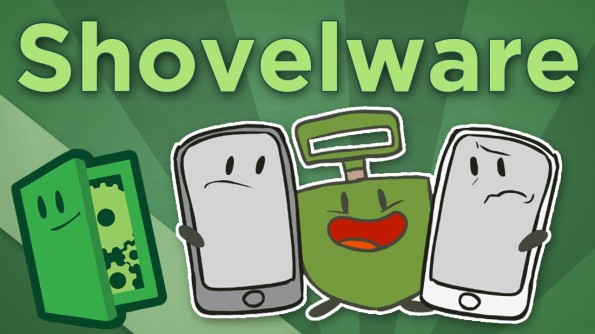
5- I hope Pokemon Go and Nintendo continue to succeed with this and open the doors further for dramatic quality improvements to mobile gaming. We can’t compare to this to the 80s arcade era or any other great era of gaming YET due to this being the only non-horrible mobile game that I can really think of that is of any legitimate note. Yes, some games are tolerable for a few minutes, but it’s virtually all brainless garbage out there.
6- Returning to the train of thought on crossing over the Pokemon Go aspect to Nintendo’s home consoles and 3DS, if they can expand this into VR, then they could give homebound kids and hospitalized/handicapped players a chance to join in the fun. Google Earth kind of world details mean you could actually explore the world without the use of your legs or perhaps endangering yourself if you suffer from poor health. The social aspect could be awesome for that community.
7- Be prepared for massive backlash. We live in an era where it’s ‘cool’ to hate on things, it’s probably already started, but it will build to tidal levels in no time. Screw those people. I don’t really care about Pokemon per se, but I’m happy to see something happen that brings people together and inspires.
Communist Beer is the Shiz Niz
Local Brewery to me, in Downtown Dallas, produces this beer that is surprisingly good. Community’s WitBier. It’s the type of beer that is refreshing on a hot day, or after some hard work. Like mowing the yard, or busting knuckles under the hood. It’s highly carbonated, Belgian Style White, what ever that means, but to me, it is a smooth and easy drink. It has a definite orange flavor but not to the extent of a BlueMoon. If you see one give it a try. This is currently my favorite go to. If your in the Dallas area, The Rustic has it on tap.
The origins of Home Game Console wars, by John Hancock
John Hancock generously lent some time for us to cover some very cool early history of home gaming consoles, and here is his article on the subject at hand. Thank you very much sir! – Thor
It is hard to believe that videogames have been commercially available for nearly 40 years. A lot has transpired in that time, and a lot of history has been written on the matter. Recently I noticed a trend in newer gamers that have started gaming in the mid 90s. Many of them admitted that their first videogame experiences were with systems such as the Super Nintendo and the Sony Playstation. For many, their whole experience of gaming began with a Nintendo System. From this observation, there is a ton of early videogame history that is often forgotten about or ignored due to it happening before people were gaming now were born.
EARLY DAYS
Believe it or not, commercial video gaming goes back to 1972. The first videogame console was designed by Ralph Baer, considered the “Godfather of Videogames”. Released by the company Magnavox, the crude first generation game console ran off of batteries and looked more like a vacuum cleaner than a game console. The console came with a series of game cards that when inserted into the game system, turned the system on. The primitive graphics of the system were used in conjunction with color overlays that were placed on the TV set. The system went on to sell approximately 330,000 units and was discontinued in 1975. The Odyssey did not even have a microchip in it!
The Success of Pong
While Magnavox was first to produce a home console, a small company at the time by the name of Atari was to improve upon the idea and release its own version of gaming. Atari became famous with the success of its Arcade game Pong, an action game of just hitting a ball between two bars. After a couple of years of success with Pong in the arcades, Atari created a home version of the arcade game and marketed the system to larger retail chains before finding their first buyer…Sears. The Sporting Goods Department of Sears. Working an exclusive deal, Sears was first to market exclusively The Atari Pong System in their own stores under the Sears brand “Tele-games”. 150,000 units were made for Sears, selling at just below $100 each for the 1975 holiday season. The next year Atari released their own Branded Pong unit.
Attack of the Clones
Success can be a tricky thing. Become too successful and watch others come in to swoop in on the craze. Pong was no different than any other hyped product. Within just a short span of a year, other companies began to pop up creating and retailing their own versions of pong units. Varying shapes and sizes, and essentially offering the same game in different packages, From 1976 through 1978, hundreds of console designs from various companies were created to cash in the craze. Pong Clones were made around the world, some with really unique designs. The market came crashing down for Pongs by the end of 1977, when Atari released the home console that would change the world.
The Slow Rise of the Video Computer System(a.k.a. the 2600)
Atari was not to first create a home console that could play different games on cartridges. That distinction belongs to another company, called the Fairchild Channel F, released in 1976. The system could play distinct different cartridges, which were brightly colored in yellow plastic. Seeing the sales of Atari Pong diminish, Atari moved forward with its next new home system the Video Computer System seeing that pong units were now obsolete. Being that Atari was a small company needing to be infused with revenue, it was sold to Warner Communications for around 30 million. With the revenue and marketing backing of a much larger company, the Video Computer System was released September 11th, 1977 for $199. The Video Computer System came packaged with two controllers and a pack-in game, combat. While crude in graphics, the VCS provided fast moving action and several game variants for each cartridge. The system initially had 9 games available, known as the “Gatefold 9” due to their gatefold packaging. Cartridges were available for around $30. While the Atari sold better than it competitors, it was considered a semi-successful launch at selling 250.000 units.
The Golden Age of Gaming
The late 70s to early 80s was a great time for gaming. The home market was starting to blossom. A lot of creativity was being programmed into many classic videogames that have helped shape the gaming landscape still today. While the 2600 had an initial slow start, the release of Space Invaders in the arcades really caused a stir. Arcade gaming really began to take off. Classic games such as Asteroids, Defender, and Pac Man made a tremendous amount of money during the heyday of Arcades. There was a growing demand for people to play these games at home on their home console. In 1980, Space Invaders was “ported” to the Atari 2600. While the graphics were more primitive than the arcade counterpart of the same game, the gameplay remained the same. In 1980, Space Invaders alone went on to help Atari sell over two million units of the 2600. The success of home gaming was also not just the 2600. Magnavox Odyssey 2 was released in 1978 and went on to sell about 2 million units. In 1980, Mattel released the Mattel Intellivision and focused on sport titles and enhanced graphics. The system went on to sell over three million units. While other companies celebrated a temporary lucrative market for the home console industry, Atari was the one that owned many of the exclusive rights to successful arcade games. For many gamers, the only way to play certain arcade games was to play them on the Atari 2600.
Market Crash
The North American Video Game Crash of 1983-1985 changed the face of the games industry forever. In just two brutal years, the market went from 3.2 billion annually to 100 million in sales. No one single event caused the crash, but rather a multitude of events combined together to slam the industry, wreaking havoc and despair for many companies. Beginning in the later part of 1982, things looked hopeful. Atari released the long awaited sequel to the VCS(2600), called the 5200. The system ended up being a real dud, compounded with multiple problems. The main problem with the system was its controller, which was prone to breaking easily, along with a non centering joystick that made control difficult. Customer feedback about the system was less than stellar and sales were flat. After the success of Activision and the approval from courts for companies to create third party games for 2600, several startup companies came out of nowhere and were producing less than quality 2600 games. Atari was being hit from all sides. New arcade games were not drawing in the revenue that previous games were. Several arcades that were opened just years before started to close around the United States. A gaming glut was starting to appear in the home market. Atari own 1st-party titles were also falling flat. Lackluster titles such as E.T. were overproduced and over marketed to the mass audience. Millions of ET cartridges went unsold. In a move to recoup costs and sell current supplies of games, several retail outlets starting slashing prices of games down to mere dollars.
-John Hancock, 7-24-2013
Boy, I remember that crash when I was little. I had the interesting experience of getting into gaming just around that time. When I was about 6 years old in 1983 to 8 years old in 1985, I remember being able to go into Kay-Bee Toys and other little toy/game shops, and picking up video games for 50 cents, a dollar, and so on. Many of the titles were terrible, but the sheer volume of old unsold games was astonishing. Then I remember seeing the games disappear form those shops for a while, and I started gaming in earnest on my Atari 8-bit home computer and friends Commodore 64 machines, having to find titles at computer stores or sometimes seeing them at larger retail outlets. In my memory, the Atari 8 bit, Commodore 64, and Apple II systems sort of side-stepped the console crash due to their perceived value as more than gaming systems (although I of course did little more than play games on them, aside from messing about with Basic and some art/music programs). It wasn’t until the NES and Sega Master system appeared in wide release in the later 80s that I saw a true resurgence in console gaming, and it was bigger, better, and here to stay for the long haul.
-Thor
Thank you John!
Great news for gamers that needs to be celebrated!
Hi readers! Welcome to LostHammer and thanks for coming to visit with us!
I have an observation that I think bears consideration and celebration in our industry, one that is very easy to skim over and forget about, but one that really will be a gigantic boon to all of us, developer and gamer alike.
This secret sauce is : x86 platform becoming the de-facto standard for serious gaming!
Think about the history of gaming overall, it’s been dominated by drastically varying platforms and architectures. Even when more than one system used the same CPU, a lot of times there were wildly different special supplemental chips to consider which were crucial to making games for the platform. Well, all of that is about to go out the window in a big way!
With the current-gen stuff, you had :
PC with x86 CPU / Direct3D / OpenGL + Varying GPUs
Playstation 3 with Cell CPU + Nvidia GPU
Xbox 360 with IBM Xenon CPU + ATI Xenos GPU
What did all of this mean for developers? To start with, to do things right they had to take into consideration their weakest target platform when planning development, as being too ambitious with the design might make their plans impossible otherwise. Following that, they had to allocate very significant resources into merely getting the title ported to work correctly on each platform, even before any optimizations were undertaken. As far as optimizations, this was another round of expenses and delays, to get the title working optimally on the target platform. For gamers, this meant that there were often delays in getting versions of the titles they wanted released, and that in the $50-$60 that they spent on that title, a decent chunk of that money actually went into the resources necessary to even port the title. Lastly, less ‘proven’ titles, or entries from smaller publishers might not even see releases on multiple platforms due to the obstacles in expense and manpower.
Unification to the rescue!
What we have now moving forward with the Playstation 4, Xbox One, and PC gaming platforms is a dramatic improvement at every level. Both the PS4 and XboxOne have hardware in the exact same families and generations even, and all of it is made up of variants of ordinary PC gaming lineups. There remain differences in capability, and some unique oddball considerations such as Xbox One’s 32MB embedded cache (which remains, sadly, too small and too slow to compete with GDDR5 for top-tier 3D performance), but by and large, one can very easily develop for all of these platforms with a minimum of effort in contrast to the current status quo.
The Playstation 3 was a prime example in the negatives of having a very unique system architecture. Although a handful of titles such as Uncharted 3, The Last of Us, and so on do show the PS3’s full capabilities, far too many are simply disappointing, and this shows most clearly in cross-platform ports. Even the Xbox 360 was fairly unique in it’s own rights, however it was indisputably easier to produce titles on by comparison, and closer to the PC in terms of being able to port over easily.
Both the Xbox 360 and especially the Playstation 3 also held up game development due to their very limiting RAM setups. Even for 2005/2006, 512MB of total memory was already becoming quickly obsolete in the PC gaming world. Even taking into consideration the large overhead of the Windows operating system and APIs such as DirectX, there was still a lot more RAM to work with on PCs. This led to many PC titles showing enormous capability when coded to take full advantage of high end hardware, but much more often what happened were terrible ‘consolized’ ports that were written for systems with tiny amounts of memory, and with barely an effort at all to give PC gamers the advanced modeling/AI/maps/content that their systems were truly capable of achieving.
With the move to 8GB, these consoles are much further ahead of the curve in contrast to the 360/PS3 were at launch, even as their CPU/GPUs are somewhat weaker in the big picture compared to those days. At launch, the 360 and PS3 had GPU power that rivaled the best gaming systems out there, and only eclipsed by super expensive PCs. This time around, the GPU power in the new consoles is a bit more sedate. Still, with the large system ram and hugely updated graphics power, games should look amazing on the new consoles by comparison to PS3/360.
Perhaps the largest bonus, depending on how they roll this into their business models, will be in the reduced costs of porting titles across platforms for the developers. Now, the same budget will allow for a lot less time worrying about system X, Y, and Z, and this will shave dollars, labor expenses, and scheduling allocations out of the equation. Not only will this make more multiplatform titles almost inevitable, but it will make developers more profitable. To a team given the same amount of resources, this should enable a better final product. Instead of spending a huge amount of time optimizing for other systems and architectures, much more time can be spent making a good GAME.
This is great news for everybody. The only outlier in this regard is the Wii U, which remains on non-x86 hardware. This bodes poorly for cross-platform gaming on the WiiU moving forward, but Nintendo above all should be able to rely heavily on top-quality 1st party titles as long as they can move them along. If they get at least one full-fledged Mario/Zelda/Kart/Metroid/Smash/etc every 3-4 months at the longest, they will stay in the game as a very vibrant 3rd place. If they drop the ball, or try too much filler such as the Windwalker remake (hardly a Nintendo gamer alive wouldn’t MUCH rather see an actual new Zelda adventure before they re-skin an old title!), they may find themselves in trouble.
All in all, we’re in for a unique generation, and the potential to have the best gaming lineups in history! Thanks for reading, and comments and feedback are always appreciated!
Viking Fury : A review of Valhalla Rising
Valhalla Rising is a 2009 film from director Nicolas Winding Refn, who also penned the script along with a relative unknown by the name of Roy Jacobsen. Nicolas Refn is a quickly rising star on the critical and commercial success of the film ‘Drive’, currently in theatres.
This film really is a world apart. Let me first say that this isn’t for everyone by any means. This is a gritty, brutal, sparse, and phenomonally beautiful piece of work. You could probably fit the entire dialogue of the film on a single typewritten page or two, and there are only a few moments of any significant action. If you’re prepared for it, it’s truly a monumental achievement as a film.
The story, for what it is, follows the mute Viking slave known only as ‘One Eye’, who in the opening sequence is shown to possess such qualities of violence and fortitude that he seems hewn from the same craggly rocks and severeness of the very landscape that he inhabits. He does not celebrate, he does not mourn, he simply exists as a silent and resolute testament to the strength of his own will. As he moves through the story, he is drawn by a series of visions towards his destiny, and the sheer magnitude of his character is the undeniable center of the world in which the others revolve around. He is said to have been raised up from hell, and that’s where he aims to return.
The photography is absolutely stunning, the direction impeccable, and the music highly effective. The performances didn’t have any flaws that I noticed whatsoever. There are many scenes and indeed portions of the film with no dialogue at all, it simply is almost a dreamscape that is inhabited by these disparate and mostly violent souls. One can interpret certain elements a number of different ways, and it’s a testament to the skill of Nicolas Refn that this all comes together and works as well as it does.
I can imagine that this was a hard sell, and indeed it never saw a real theatrical release. Without a doubt this is not for everyone, I can’t stress enough that this is NOT a typical film by any measure. Think of it as a two hour exercise in the art of film, and do not expect any conventional elements.
I rate the film 10/10 for me personally, which aside from Casablanca, Citizen Kain, and Schindler’s List, I have never considered a film utterly perfect as what it was. For most viewers however, I would imagine a much lower reaction, as this couldn’t be more opposite of what dominates the box office.
Another angle on next-gen predictions: Microsoft will survive, but Sony will still win this battle.
Originally, I posted the bulk of this as a reply to LOSTHAMMER’s Next-Gen Predictions post on facebook, but the MIGHTY THOR has requested that I ‘reblog’ here, and I am honored to do so. 🙂 As I’ve never posted here or on blogs before, to introduce myself, my name is Chris Tang. Where Thor is well-known for being the Nintendo World Champion, I am the somewhat lesser-known SEGA World Champion, having won their world tour and $25,000+ Championships held at Alcatraz and televised on MTV in 1994. (I was also the Los Angeles NWC Champion, and came in 8th in the grand finals for those wondering). I’m also a 20+ year veteran in the game industry and worked at companies like Atari, Capcom, and BPS along the way, having contributed to games and franchises such as Primal Rage, Street Fighter III, Street Fighter Alpha, Resident Evil, Marvel Vs. Capcom, Transformers, and Tetris. Nice to meet you all!
TV Stole Your Memory
Thor’s post on the next-gen predictions is an amazing read – the most comprehensive article on system specs and capabilities I’ve read thus far, before or after the “Xbox 180” of yesterday, in which Microsoft reversed their draconian DRM and daily check in requirements for the system to function. (Wait, was that really just a day ago?) The only thing I found to be missing, was the issue of the Xbox One’s RAM usage in regards to system overhead. We know the RAM in the PS4 is faster than the Xbox One, but one major issue of concern is that due to Kinect 2 and the fancy-schmancy tuner system, the XBOne’s OS takes up a whopping 3GB of that RAM, leaving 5GB or less for developers to actually run the game on. While I don’t have the exact number for the PS4 – it suffers from no such overhead limitation and thus, is more developer-friendly. Also, the PS4’s DDR5 memory is unified so that it can be used for either graphics or the CPU – a unique ability that can lead to some optimizations and future features – providing a potential performance edge that not even PC games can currently utilize.
The First Year
My prediction is that starting out the gate, Microsoft will be at a slight disadvantage due to the $100 price difference, the publicized difference of specs, and of course – the loss of brand trust due to the whole DRM fiasco. There’s also people’s mistrust and apathy towards the “required” aspect of the Kinect sensor, which is one of the last glaring issues Microsoft has to address to get on more equal footing with Sony. I don’t think the gap will be even remotely as big as it could have been if they kept the anti-consumer policies in place, but they are now at least a contender if they play their cards right.
The Seeds of a Stronger Library Have Already Been Planted
For the future beyond the console’s launch year, if I were to put money on a platform with what I know now, I would still bet on Sony. Here’s why… The seeds have been planted in minds – especially at E3 – that the PS4 is more developer-friendly, and has better specs. If a talented developer has the means to make a game on either or both platforms, they will likely choose PS4 due to those factors and larger userbase resulting from Sony’s lower price point. Add to that, Sony’s embracing of indie developers; giving them the means to self-publish makes makes releasing a game possible on PS4 while it may not be economically viable otherwise. Result: the first generation of indie devs will become more comfortable and friendly with PS4 as their platform of choice. What happens to successful indie developers? They can BECOME successful AAA developers, case in point, Media Molecule – the developers of Ragdoll Kung Fu, Little Big Planet, and the upcoming Tearaway. Unless Microsoft finds, then outright buys, pays, or supports promising indies directly, those up and coming stars of the next-next generation will plan to launch their creativity on PS4, not the Xbox One. As an indie developer myself (despite my lengthy career having started at AAA companies), the choice for the current platform is a no-brainer. A year from now, the developer preference will most greatly affect the indie selection of offerings, but in 3 or 4 years it will begin to affect the main library as the talent blooms, grows, and evolves. Microsoft’s insistence on publisher-publishing and outrageous fees for title updates compound this problem that may compromise their game library’s quality and diversity down the road.
You Need to be the Target Platform
The difference in hardware power may not seem like much on paper, but given what happened last generation where the more-difficult-to-develop-for PS3 often produced inferior versions of the same game despite the potential of the system, it is now more crucial than ever to be the “target platform”. Despite what first party console makers may have you believe, multi-platform games DO matter, and not all versions of a multi-platform game are created equal. The repercussions of not being the target platform can be deadly, as the system that sells less software units can easily become a dumping ground for “bad ports”. As we saw in the last generation, secondary platform SKU’s often suffer from low framerates and much less polish and optimization from those that are the target. Publishers tend to show their best SKU off the most, and sweep their quasimodo ugly version under the rug, only to have those flaws revealed by irate customer reviews upon release. This problem tends to multiply itself as gamers who own both platforms generally buy the better performing version, leading to lower sales for the other; lower potential sales means a lower priority for developers and publishers. With PS4’s better specs, lower price = larger userbase, and more generous development policies, the roles for this generation may be reversed; Sony is in the perfect position to claim primary SKU status for the upcoming console generation. The difference in quality may become more apparent as the systems mature, when higher development costs invoke the “bad ports” phenomenon. At some point it becomes economically unviable to spend the extra resources to make the lesser-selling or more difficult to develop version perform up to standards.
A Winner is You
I am very happy that Microsoft reversed their DRM policies, and I can say with confidence that I will own both platforms eventually. Competition is a good thing, and even though I feel Microsoft is at a disadvantage – and deservedly so for attempting such offensive anti-consumer tactics – I’m glad they survived. Even if the Xbox brand loses in this generation, they now have a chance to come back in the next hardware generation. Sony learned from the mistakes they made when they launched the PS3, and now it is Microsoft’s turn to regroup. This epic battle between brands has been unlike anything seen before in the game industry – or any industry for that matter. We saw the creation of evil, heard the plight of the masses, and saw a champion rise to the cheers of the people. What happened here has taught the industry an important lesson and gives players an unprecedented voice, the likes of which have never been heard. The future is promising, and it is empowering to know that as players and consumers, we can make a difference.
An update on the supposed ‘Family Plan’ on Xbox One
An update on the supposed ‘Family Plan’ on Xbox One
There was some outcry over the Microsoft Xbox One ‘180’ on DRM, which cancelled the ‘family sharing plan’ where up to 10 users could digitally share titles. I had already said that it probably wasn’t anywhere near as good as it was made out to be. This looks to absolutely confirm those suspicions. Gamers win. Xbox fans win.


